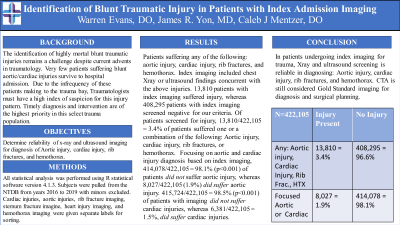Trauma
Category: Quickshot Oral Session 09
Quickshot Oral : Quickshot Oral Session 09
IDENTIFICATION OF BLUNT TRAUMATIC INJURY IN PATIENTS WITH INDEX ADMISSION IMAGING
Sunday, February 12, 2023
7:00am - 8:00am East Coast USA Time


Warren Evans, D.O.
Surgery Resident
Spartanburg Regional Medical Center , United States- JY
JAMES YON, MD
TRAUMA/ACS ATTENDING
NOVANT HEALTH, United States
Presenter(s)
Principal Contact(s)
Objectives: Blunt traumatic injuries remains a challenge to diagnose expediently. Given the rarity of severe blunt injuries: aortic injury, many of these patients expire prior to hospital admission. It is for this reason we must expediently identify injuries in these patients in order to provide lifesaving care with a very narrow window for clinical diagnostic error. We want to inquire how reliable imaging such as Xray and Ultrasound are at identifying: Aortic injury, cardiac injury, rib fractures, and hemothorax.
Methods: All statistical analysis was performed using R statistical software version 4.1.3. Subjects were pulled from the NTDB from years 2016 to 2019 with minors excluded. Subjects were labelled using ICD codes for several chest injuries/imaging. Cardiac injuries, aortic injuries, rib fracture imaging, sternum fracture imagine, heart injury imaging, and hemothorax imaging were given separate labels for sorting. The sample consists of subjects with any of the above injury labels OR any of the above imaging labels. Subjects were then separated into two groups based on the above labels: injury and imaging labels present vs. imaging label present but no injury label present. This two group comparison used chi-squared test for all categorical variables. Wilcoxon test was used for the two group comparison as all continuous variables tested as non-normal using Shapiro-Wilks test.
Results: A retrospective review the NTDB we identified n=422105 patients received admission imaging. This included patients suffering: Aortic injury, cardiac injury, rib fractures, and hemothorax. Index imaging included chest Xray or ultrasound findings concurrent with the above injuries. 13,810 patients with index imaging suffered injury, whereas 408,295 patients with index imaging screened negative. Patients screened for injury, 13,810/422,105 = 3.4% patients suffered one or a combination of the following: Aortic injury, cardiac injury, rib fractures, or hemothorax. Focusing on aortic and cardiac injury diagnosis based on index imaging, 414,078/422,105 = 98.1% (p < 0.001) of patients did not suffer aortic injury, whereas 8,027/422,105 (1.9%) did suffer aortic injury. 415,724/422,105 = 98.5% (p < 0.001) of patients with imaging did not suffer cardiac injuries and 6,381/422,105 = 1.5%, did suffer cardiac injuries.
Conclusion: In patients undergoing index imaging for trauma, Xray and ultrasound screening is reliable in diagnosing: Aortic injury, cardiac injury, rib fractures, and hemothorax. This rare injury pattern needs a high index of suspicion but can be potentially identified with bedside imaging early in the evaluation of the trauma patient. CT angiography is still the gold standard imaging needed to assess injury severity.
Methods: All statistical analysis was performed using R statistical software version 4.1.3. Subjects were pulled from the NTDB from years 2016 to 2019 with minors excluded. Subjects were labelled using ICD codes for several chest injuries/imaging. Cardiac injuries, aortic injuries, rib fracture imaging, sternum fracture imagine, heart injury imaging, and hemothorax imaging were given separate labels for sorting. The sample consists of subjects with any of the above injury labels OR any of the above imaging labels. Subjects were then separated into two groups based on the above labels: injury and imaging labels present vs. imaging label present but no injury label present. This two group comparison used chi-squared test for all categorical variables. Wilcoxon test was used for the two group comparison as all continuous variables tested as non-normal using Shapiro-Wilks test.
Results: A retrospective review the NTDB we identified n=422105 patients received admission imaging. This included patients suffering: Aortic injury, cardiac injury, rib fractures, and hemothorax. Index imaging included chest Xray or ultrasound findings concurrent with the above injuries. 13,810 patients with index imaging suffered injury, whereas 408,295 patients with index imaging screened negative. Patients screened for injury, 13,810/422,105 = 3.4% patients suffered one or a combination of the following: Aortic injury, cardiac injury, rib fractures, or hemothorax. Focusing on aortic and cardiac injury diagnosis based on index imaging, 414,078/422,105 = 98.1% (p < 0.001) of patients did not suffer aortic injury, whereas 8,027/422,105 (1.9%) did suffer aortic injury. 415,724/422,105 = 98.5% (p < 0.001) of patients with imaging did not suffer cardiac injuries and 6,381/422,105 = 1.5%, did suffer cardiac injuries.
Conclusion: In patients undergoing index imaging for trauma, Xray and ultrasound screening is reliable in diagnosing: Aortic injury, cardiac injury, rib fractures, and hemothorax. This rare injury pattern needs a high index of suspicion but can be potentially identified with bedside imaging early in the evaluation of the trauma patient. CT angiography is still the gold standard imaging needed to assess injury severity.

